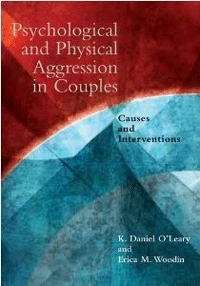Psychological and Physical Aggression in Couples: Causes and Interventions

“Psychological and Physical Aggression in Couples: Causes and Interventions”
Edited by K. Daniel O’Leary and Erica M. Woodin
American Psychological Association
Washington, D.C., 2009
Domestic violence book helpful to clinicians
By Paul Efthim, Ph.D.
Do batterer intervention programs work? Not as much as we might think, according to a new book on aggression in couples.
The rate at which batterer programs reduce recidivism is low, ranging between zero and five percent. Although any decrease in domestic violence is valuable, some observers argue that such programs – with their promise to reeducate offenders – inadvertently engender a false sense of hope and security. Indeed, most research concludes that batterer intervention adds very little effectiveness over and above the effects of arrest alone.
Dire as these findings sound, they should not be interpreted as conclusive. The quality of the research is far from optimal; no controlled studies have been conducted. Practical limitations impede experimentation that would help identify which approaches are most effective. But there remains no doubt that batterer intervention is “a work in progress.”
To address these and other critical problems, co-editors K. Daniel O’Leary and Erica Woodin have published an outstanding review of what we know about the prevalence, causes and treatment of psychological and physical aggression in intimate relationships. Four psychologists from New England contributed chapters: Denise Hines of Clark University, Kimberly Saudino of Boston University, and Candace Munson and Casey Taft of the Boston VA Medical Center. As a group, the contributors care deeply about victims of aggression and articulate a sociocultural analysis of men’s violence against women while also acknowledging women’s aggressive behavior in intimate contexts.
Several clinical implications emerge from this comprehensive text. First, practitioners should evaluate physical and psychological aggression in working with couples, families and individuals. Secondly, the evidence argues against a “one size fits all” approach. Because batterer programs tend to be less effective for individuals with psychopathology, those people may need different treatment approaches.
To its credit, the book highlights the interplay between psychological and physical aggression, two topics often studied in isolation from each other. Research has become increasingly sophisticated in examining not only violent behavior but also subtle forms of aggression that go unacknowledged by couples and professionals alike.
Clinicians might be surprised to learn how common such behavior can be. In clinic samples, roughly half of all couples, when questioned carefully, report one or more incidents of physical aggression in the preceding year. Even more startling, approximately 95 percent of these same couples report psychological aggression in the same time frame.
An example of psychological aggression is the abandonment threat. In the heat of an argument, an exasperated partner declares, “It’s over!” Such statements can produce panic in a vulnerable partner and escalate the fight. Non-violent couples who present for treatment often have no idea how destructive and destabilizing such talk can be and usually welcome education and limits on verbal aggression.
O’Leary and Woodin structure the volume in three parts. The opening section looks at the prevalence of partner aggression, including across cultures. Several chapters cover familial, sociocultural, genetic and psychological factors associated with partner aggression. The final section focuses on intervention strategies, prevention, substance abuse and approaches to working with individuals, groups and couples.
The book does an excellent job addressing the controversy between grassroots pro feminist models of batterer treatment and therapeutically-oriented approaches. The authors illustrate different models and suggest that no current approach can claim superiority based on the available research. They argue for a new paradigm that tailors intervention strategies to the individual.
One of the book’s few shortcomings is definitional: “psychological aggression” is not clearly defined. For example, sulking is mentioned as a form of aggression. If we use the construct that broadly, it may lose its explanatory power (while also implicating those of us who indulge in the occasional sulk). Other limitations of the book include insufficient attention to gay and lesbian relationships as well as a lack of case illustrations that would have increased accessibility for clinicians.
This book is a must-read for specialists in the field of domestic violence. Clinicians who are not afraid to delve into the latest research will also appreciate this high-quality overview.
Paul Efthim, Ph.D. is a licensed psychologist in private practice in Brookline, Mass. and holds a faculty appointment at the Boston Institute for Psychotherapy.
Learn more about the book: Psychological and Physical Aggression in Couples: Causes and Interventions
